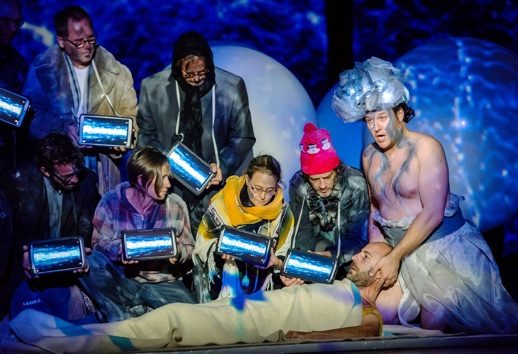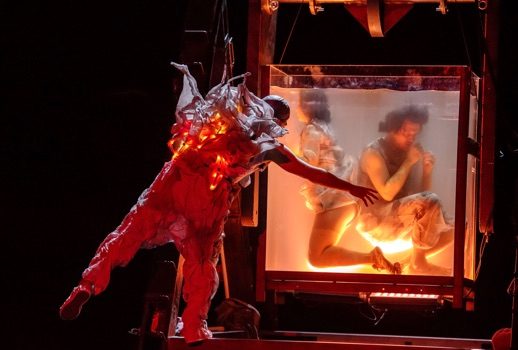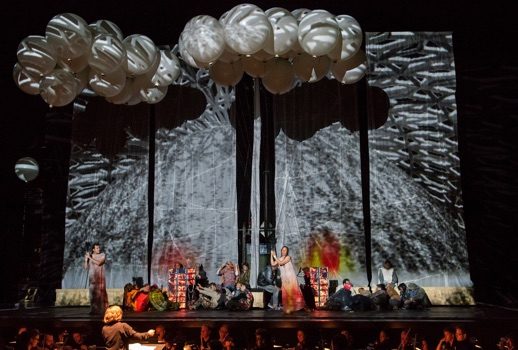

The malodorous work behold amaz’d.
After a more than two month hiatus from reviewing, I was psyched. One of music’s soaring miracles and one of my very favorite works—Haydn’s Die Schöpfung—was being performed by an intriguing, buzzed-about conductor leading her own period-instrument orchestra and acclaimed chamber chorus in a provocative staging by the controversial Catalan theater collective La Fura dels Baus. What could go wrong? As it turned out: just about everything!
Haydn’s late masterpiece evoking God’s creation of the world is set to texts drawn from the Bible and Milton’s Paradise Lost and contains no dramatic action per se and recounts the events of the earth’s first seven days. But unlike many of Handel’s oratorios which have lately been staged with increasing regularity, beyond the sweetly pastoral duets of Adam and Eve in the third and final part there’s little theatrical interaction between the archangels which dominate most of The Creation.
But some reason Lincoln Center’s newly rejiggered Mostly Mozart Festival imported this ugly, awkward attempt Thursday evening for the first of two performances at the Rose Theater. Director Carlus Padrissa’s baffling program note proclaimed that his work flowed from the profound revelation that the letters in Haydn’s name contain “DNA,” the cell structure present in nearly all living things.
He then connected this discovery to the Big Bang and it to the thrilling climax early in Haydn’s work on the word “Licht.” Unfortunately the entirety of his plodding, nearly two-hour traversal took place in a darkness so enveloping that we never clearly saw his performers’s faces.
Not only are his three heroic soloists—Christina Landshamer, Robin Tritschler and Thomas Tatzl—thus hindered in communicating with their audience, the trio were also regularly strapped into harnesses and suspended high above the stage or dunked into a smallish tank of water in which they thrashed and gasped.

Awake the carp, the mire awake.
If any of this repetitive and laborious business had been either visually or dramatically arresting it might have been worth the jarringly noisy distractions it entailed. The sole exception might have been when Adam and Eve were cranked ecstatically upward from the tank on side-by-side pulleys while the members of the chorus (each holding a beach-ball-sized helium-filled white balloon—don’t ask) filled the aisles of the theater and chanted in awe.
This striking image of course necessitated that the soprano and baritone had to afterward towel themselves down during their subsequent duet—a clunky action repeated several times during the damp evening. Shrouding the stage in darkness couldn’t disguise the crew of hard-working stagehands as they throughout assisted the awkward and resolutely unmagical action.
Presumably we were meant to be distracted by the constantly-swirling black-and-white projections. But they were generally so prosaic that all I could think of was how much more inventively William Kentridge does the same sort of thing.
When not being immersed Landshamer and Tatzl spent much of Parts I & II in turbans accessorized with a sort of miner’s headlight and garbed in flowing robes embellished with LED lights that twinkled on and off—presumably on cue. The soprano initially sang with a glassy shallow tone but by her transformation into Eve she was pouring forth warmly gleaming phrases filled with awe and excitement.
Tatzl sounded more like a baritone than the bass-baritone his bio claimed and thus was occasionally challenged by Raphael’s lower-lying music. His ringing, virile Adam though was much more pleasing. Tritschler’s impish Uriel overcame his blinking angel wings and narrated all three sections of the work with an attractively mellifluous high tenor.

With ordure clad the fields appear.
If only they had had in command a conductor with a satisfactory vision of The Creation (the projected texts throughout were in English though everyone sang in German), but unfortunately Laurence Equilbey’s concept proved a scattershot collection of individual effects and “ideas.” Though her Insula Orchestra sometimes brought arresting and unexpected colors to Haydn’s vivid writing, her tempi were generally fussily attenuated and lacked much sense of overarching structure.
When not trailing balloons, accentus, Equilbey’s 36-member chorus, grasped flashing iPads and oddly made little impact in the glorious choruses that dominate the work. Only when they lined the front of the stage for the first verse of “Vollender ist das grosse Werk” did they ring out with a thrilling vibrancy; when placed farther back for the repeat their effect was diminished considerably. More often than not, the usually thrilling choral numbers emerged annoyingly micro-managed and mannered.
Never in the many times I’ve heard Die Schöpfung (unstaged) have I been eager for it to end, but by the time Padrissa was bombarding us with cascading projections of banal proscriptive aphorisms and transforming the blankly anonymous chorus members into abused migrants I couldn’t wait to flee.
I shared the first elevator down to Columbus Circle with Peter Gelb and Victoria Newhouse, who both looked equally dismayed by the goings-on. One hope that the festival’s upcoming home-grown musical presentations will do better for Mozart than this lumbering behemoth did for Haydn’s radiantly life-affirming work.
I’m most excited by a Mostly Mozart concert labeled “Prague Symphony” next month which focuses on the composer’s relationship to the Czech city. Christian Zacharias conducts and plays one of the great later piano concerti and the glowing Italian soprano Rosa Feola makes only her second New York appear to perform two of the greatest concert arias: “Bella mia fiamma” and the sublime K. 505 in which she will be joined by Zacharias.
The festival concludes as always with Mozart’s Requiem led this time by musical director Louis Langrée and featuring the US debut of Belgian soprano Jodie Devos.
Photos: Stephanie Berger

























Comments